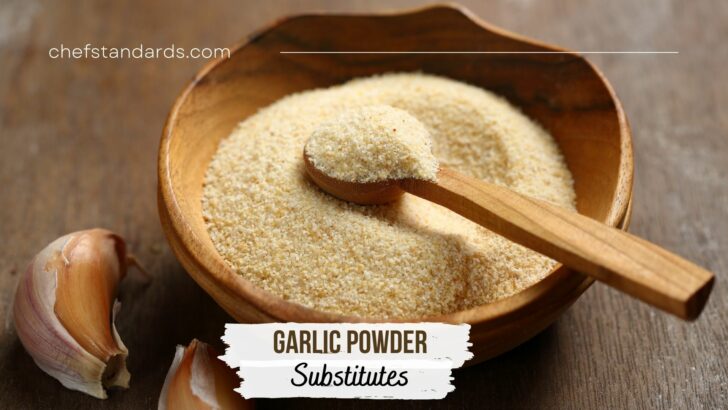Garlic is definitely one of the most used ingredients in cooking. There are numerous dishes that it can enrich, including soups, stews, bread, pizza, and so on.
The great thing is that it is not limited to its whole form, but you can find it in various different forms, including powder.
Garlic powder has become very popular recently because it provides dishes with that specific garlic flavor and, at the same time, it is very easy to use.
But what if there isn’t any left in the pantry and you don’t have time to visit the grocery store? Or you just want to make a change.
In those cases, garlic powder substitutes can be very helpful.
1. Granulated Garlic
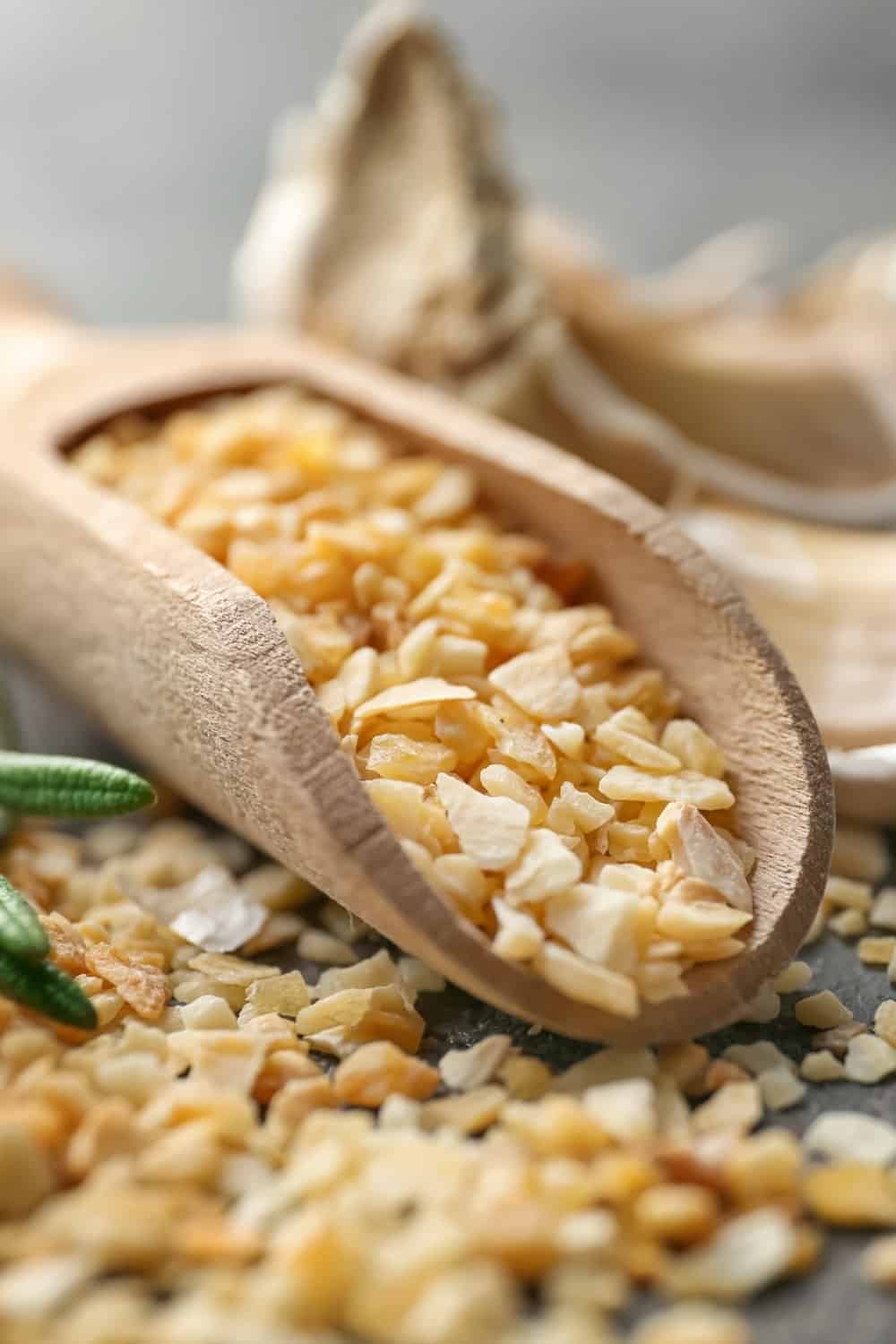
Granulated garlic is a product that consists of garlic cloves that are ground into tiny granules. Although the texture is not the same, it is by far the best substitute because of some other similarities between the two.
Similarities:
• Both of these garlic products are made from garlic cloves; however, one is ground to make granules, while the others are ground to make a fine powder.
• Their flavor profiles are practically the same, as they both have that specific garlic powder flavor, i.e., a mild garlicky taste with sweet undertones.
• Since they are made from garlic cloves, they both possess high amounts of certain nutrients, especially iron and Vitamin B6.
Differences:
• The most obvious difference between the two is their texture. While one has a fine powdery texture, the texture of the other is granulated, as their names suggest after all.
• Although they are both good sources of the same nutrients, the granulated form of garlic is slightly less valuable in terms of nutrition.
How To Use As A Substitute:
Since these two garlic products are so similar, you can use garlic granules in every recipe that calls for garlic powder. However, you have to make some adjustments.
First you have to know that the same amount of garlic powder actually represents more garlic than granulated garlic.
So, when substituting, you will have to double the amount of granulated garlic to get the same flavor profile.
One more thing to know is the fact that granulated garlic contains solid crystals, it takes longer to blend with the dish. On the other hand, garlic powder blends within just a few seconds.
All you have to do is to add granulated garlic to your dish earlier to give it some time to merge. After that, it will provide the same flavor and aroma that garlic powder can offer.
2. Garlic Salt

Garlic salt is simply a mix of garlic and ordinary sea salt. Since one of its main ingredients is garlic, it is only logical that it can be a good substitute for garlic powder. However, it also contains salt, so you need to be careful when substituting.
Similarities:
• Like with garlic powder, the main ingredient of this product is also garlic.
• Although not the same, garlic powder and garlic salt have similar garlicky flavor profiles.
• Like garlic powder, you can find garlic salt at most grocery stores and supermarkets nowadays.
Differences:
• The biggest difference between the two is the fact that garlic salt contains sea salt, which adds it more flavor and that distinctive salty taste. This may not be suitable for certain dishes.
• The other difference lies in their textures, i.e. garlic powder has a somewhat crumbly texture, while the texture of garlic salt is similar to flour or cornstarch, which is smooth and easy to work with.
• When it comes to health and nutrition, both have similar nutritional values due to the presence of garlic, but garlic salt is a little bit unhealthier because of its high salt content, which can increase blood pressure and increase risk of heart disease and stroke.
How To Use As A Substitute:
The first thing you need to know when making this substitution is the fact that garlic salt is less versatile than garlic powder.
However, it can be perfect for sprinkling over cooked dishes. You can use it in dishes like seasoned fries, raw vegetables, or even popcorn if you are a fan. I sometimes use it to season my Kennebec fries in order to make a flavorful twist.
It is best to use double the amount of garlic powder, but you have to know that additional regular sea salt must be limited in order to avoid too salty dishes.
This can easily ruin the flavor of your dish, but it can also be dangerous to your health since high salt content is not a good thing at all.
3. Fresh Garlic
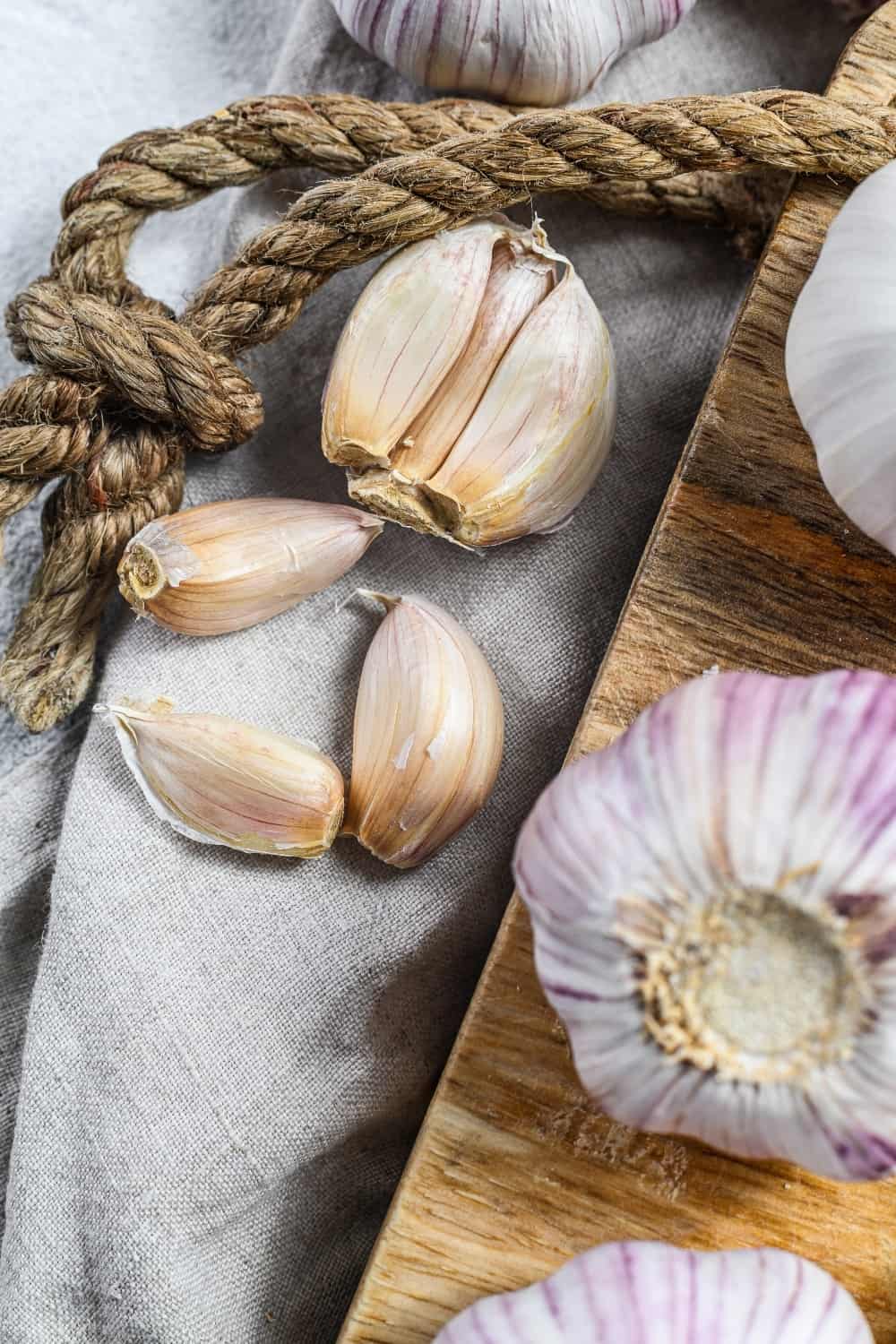
What is the more logical substitute for garlic powder than the fresh garlic itself? Although it sounds perfect, fresh garlic isn’t actually an ideal alternative, and there are a few reasons for that.
Similarities:
• Since garlic powder is actually a form of garlic itself, they have similar flavor profiles.
• Both fresh garlic and garlic powder can be used in a wide range of cooking applications.
Differences:
• Compared to garlic powder, fresh garlic offers a stronger and more robust flavor.
• Unlike garlic powder, fresh garlic requires preparation before use. It needs to be peeled, chopped, minced, or crushed, which can be time-consuming.
• Fresh garlic also has a relatively short shelf life, especially compared to shelf-stable garlic powder.
How To Use As A Substitute:
Before you cook anything, you first need to prepare the garlic, i.e. peel the fresh garlic cloves and remove any green sprouts if present.
1 garlic clove equals about ¼ teaspoon of garlic powder. However, you have to know that this ratio can vary depending on personal taste preferences and the specific recipe.
Considering that, it is also important to choose the appropriate form because that is also the factor that influences the flavor intensity. Namely, minced or crushed garlic will release more flavor, while sliced garlic has a milder taste.
Now that your garlic is ready, you have to consider the recipe because it determines the exact cooking time.
If you are sauteing ingredients, you must add minced or crushed garlic towards the end of the cooking process.
If you are roasting vegetables or meat, it is best to add sliced or whole garlic cloves directly to the roasting pan.
Finally, if you are making soups, stews, or sauces that require boiling or simmering, you should add minced or crushed garlic at the beginning of the cooking process.
One of my favorite ways to use fresh garlic is to incorporate it into Benihana garlic butter.
4. Dried Garlic Flakes

Dried garlic flakes, also known as dried minced garlic, are a dehydrated form of garlic. If you happen to have some on hand, they can be a great alternative for garlic powder.
Similarities:
• Just like with previous substitutes, dried garlic flakes and garlic powder are both derived from the same plant.
• Both garlic flakes and garlic powder have a distinct garlic flavor. While the intensity may vary depending on the specific product, they both provide a characteristic garlic taste to dishes.
• Garlic flakes also retain some of the original appearance of fresh garlic, which can add some visual appeal to your dishes.
Differences:
• Dried garlic flakes have a coarser texture, while garlic powder has a fine and powdery texture, similar to other spice powders.
• Garlic flakes can vary in size, ranging from small to larger pieces, whereas garlic powder is uniformly ground into a fine powder.
• Also, garlic powder tends to have a more concentrated flavor compared to dried garlic flakes.
How To Use As A Substitute:
Since garlic powder has a bit more concentrated flavor when compared to dried garlic flakes, you may have to use a bit more when substituting.
You can substitute approximately 1½ teaspoon of dried garlic flakes for 1 teaspoon of garlic powder.
If you want them to release their flavor, you may have to rehydrate them, and there are two good ways to do that.
You can let them soak in warm water for about 15 to 20 minutes until they soften.
Instead of pre-soaking, you can incorporate them directly into your recipe while it’s cooking. The flakes will rehydrate and release their flavor during the cooking process.
Also, you need to adjust the cooking time when using rehydrated garlic flakes, i.e. a longer cooking time can help them soften and infuse their flavor.
5. Garlic Puree
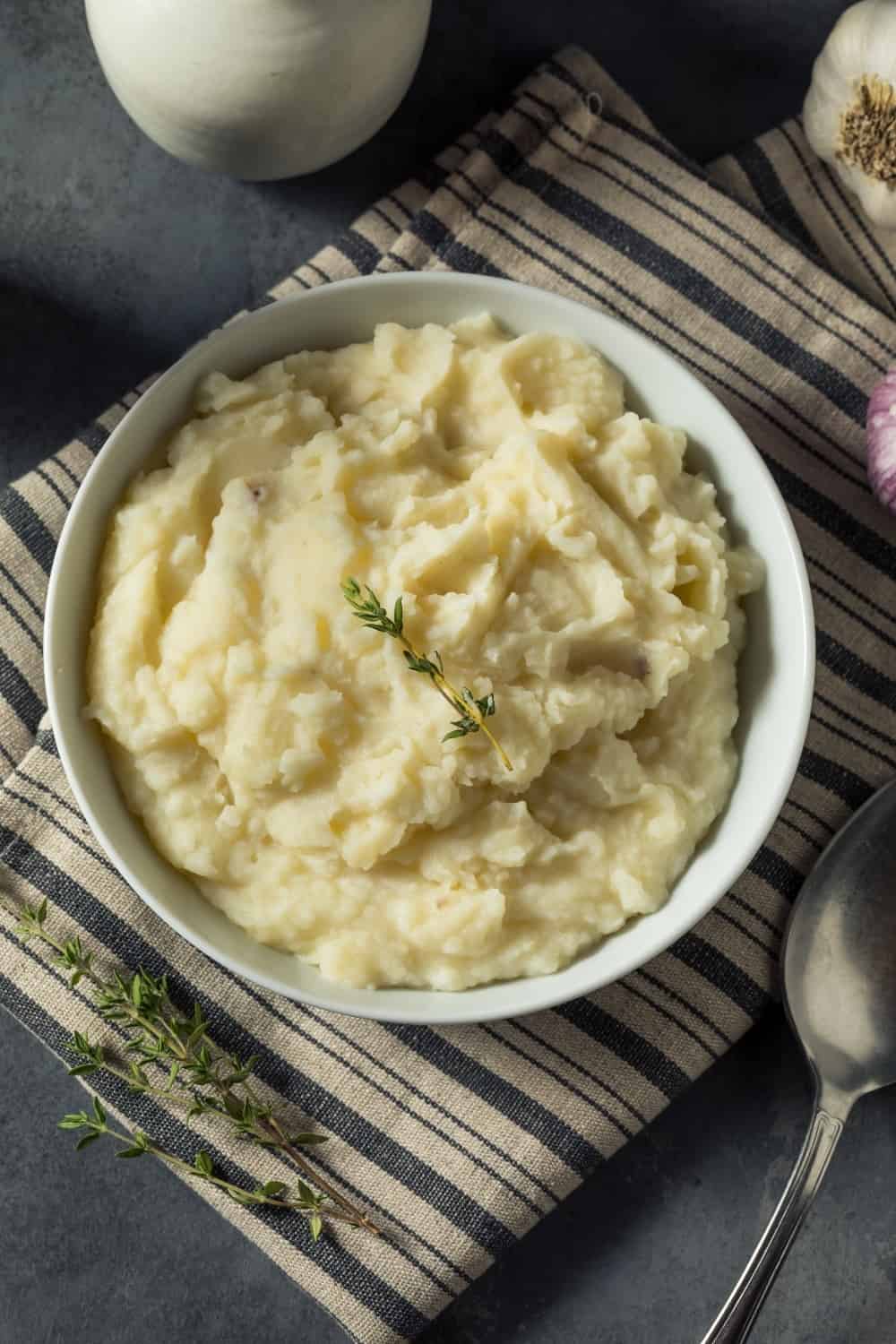
Another popular garlic product, garlic puree, has a smooth, paste-like consistency made from fresh garlic cloves. As it comes from the same plant and has a similar flavor, it can replace garlic powder in some recipes.
Similarities:
• Both garlic puree and garlic powder share the characteristic garlic flavor, i.e. a distinct, pungent, and savory taste.
• Both forms of processed garlic offer convenience in the kitchen, i.e. they eliminate the need for peeling, mincing, or crushing fresh garlic cloves, saving time and effort during meal preparation.
• Although their shelf lives differ, both products offer longer storage options compared to fresh garlic cloves.
Differences:
• Garlic puree has a thick and creamy texture, while garlic powder has a fine, powdery texture.
• Although similar in flavor, garlic powder is more concentrated.
• Garlic puree is suitable for recipes where the texture and moisture content are important, while garlic powder is more convenient for dishes that require long cooking times or when a consistent garlic flavor is desired throughout the dish.
How To Use As A Substitute:
Since garlic puree and garlic powder have different flavor concentrations and moisture contents, it is important to adjust the amount when substituting one for the other.
My recommendation is to use ½ to 1 teaspoon of garlic puree for every ¼ teaspoon of garlic powder.
Since garlic powder has a thicker and wetter consistency, you may need to compensate for the added moisture by reducing the liquid content in the recipe or adding additional dry ingredients to balance it out.
Timing of addition is also very important. Garlic puree is usually added at the beginning of the cooking process.
Garlic puree, on the other hand, can be added towards the end so that it can retain its freshness and pungency.
6. Garlic Juice
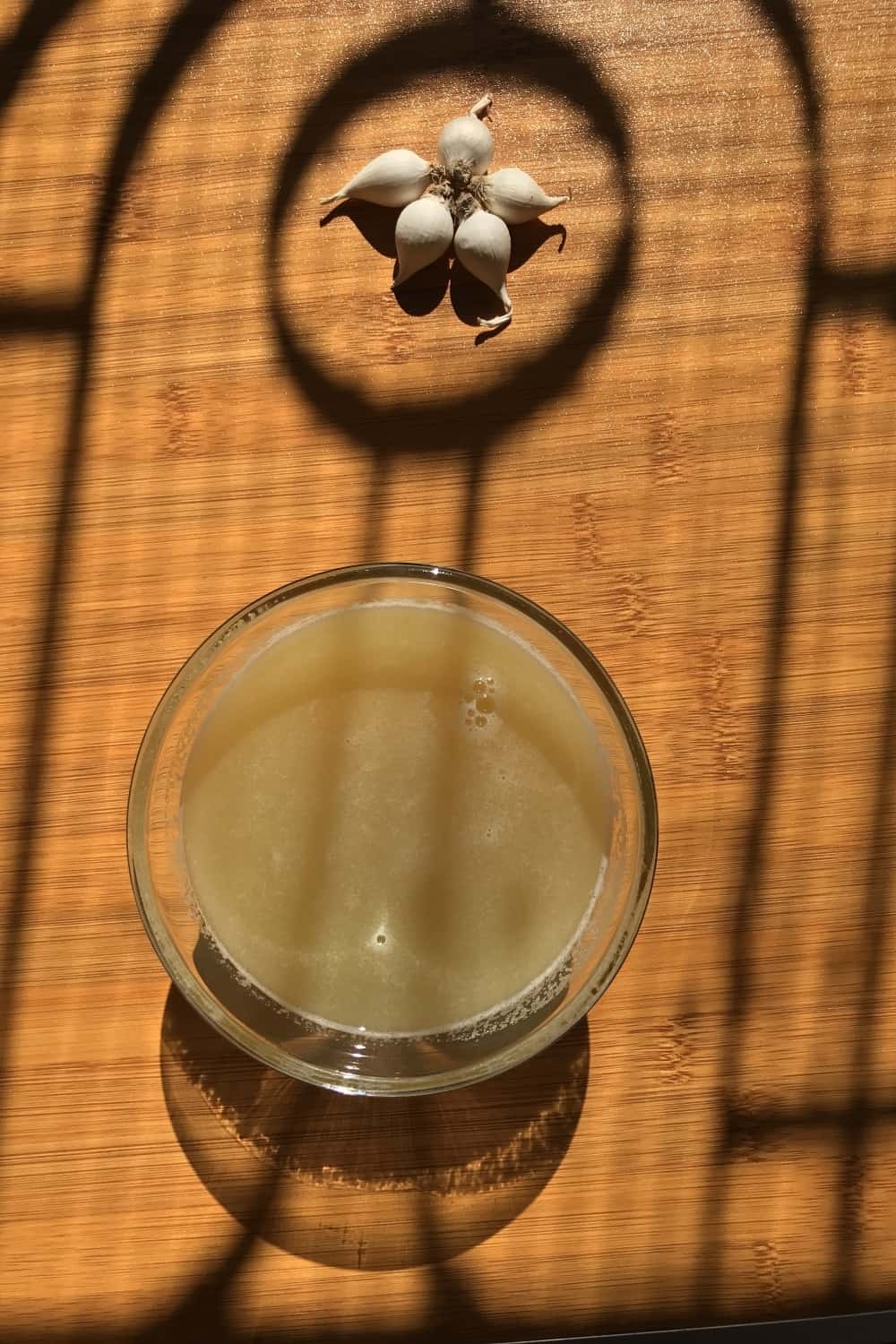
As you can easily guess, garlic juice is extracted from garlic cloves. It is typically obtained by crushing or pressing garlic cloves and then straining the resulting liquid. Garlic juice is known for its strong and pungent flavor, similar to that of garlic itself.
Similarities:
• Both garlic juice and garlic powder are derived from fresh garlic cloves.
• They both offer a concentrated garlic flavor, i.e. they possess the distinct pungent and aromatic taste associated with garlic.
• Garlic juice and garlic powder provide convenient alternatives to using fresh garlic cloves as they are shelf-stable and have a longer storage life compared to fresh garlic.
Differences:
• Garlic juice is a liquid extract obtained by crushing or pressing fresh garlic cloves and straining the liquid, while garlic powder is made by dehydrating and finely grinding the garlic cloves.
• Garlic juice is more concentrated in flavor than garlic powder. Since it is an extract of garlic cloves, the juice captures the intense garlic taste. Garlic powder, while still potent, is slightly milder in flavor.
• While both products are nutritious and healthy, garlic juice is exceptionally healthy, and may be the healthiest garlic product of all.
How To Use As A Substitute:
You first have to know that garlic juice is twice as concentrated in flavor as garlic powder.
This means that you’ll have to use about ½ teaspoon of garlic juice to replace 1 teaspoon of garlic powder.
Also, since this is a liquid, it is best to add it during the cooking process. I prefer to add it at the beginning of cooking in order to allow the flavor to infuse and distribute throughout the dish.
You may also have to dilute it with a small amount of water or another liquid if the recipe calls for garlic powder to be mixed with other ingredients. Namely, this ensures that the flavors are properly balanced.
You can use garlic juice in various dishes, including sauces, dressings, marinades, soups, stews, and more, to enhance the flavor with a garlic essence.
7. Chives

Scientifically known as Allium Schoenoprasum, these veggies that start with c are native to Europe, Asia, and North America. Chives and garlic share the same family, so it is no surprise that they can serve as a decent alternative.
Similarities:
• Chives and garlic powder are both derived from plants belonging to the Allium family, which includes onions, garlic, leeks, and shallots. Chives belong to the species Allium Schoenoprasum, while garlic powder are from Allium Sativum.
• Both chives and garlic powder offer a distinct and flavorful taste, and they contribute to enhancing the overall flavor profile of a dish.
• They are both commonly used as culinary ingredients as they are versatile and can be added to a wide range of dishes to add flavor and aroma.
Differences:
• Chives are a herbaceous perennial plant with long, thin, hollow stems resembling grass blades. In contrast, garlic powder is a dried and powdered form of garlic cloves, resulting in a fine texture.
• Chives have a mild and subtle onion-like flavor that adds a fresh and delicate taste to dishes. On the other hand, garlic powder provides a more concentrated and pungent garlic taste.
• Chives have a delicate, grass-like texture, while garlic powder has a fine and powdery texture.
How To Use As A Substitute:
First, when it comes to conversion ratio, you can use approximately 1 to 2 teaspoons of finely chopped fresh chives to replace 1 teaspoon of garlic powder.
It is best that you add them towards the end of the cooking process or as a garnish to preserve their delicate flavor. The high heat and extended cooking time can diminish their taste, so it’s ideal to sprinkle them over the dish just before serving.
You can add them to a variety of dishes for a subtle onion-like flavor. They work especially well in salads, soups, omelets, creamy sauces, mashed potatoes, stir-fries, and as a topping for baked potatoes or roasted vegetables.
One more piece of advice is to consider the texture. Chives provide a fresh, slightly chewy texture unlike the dry and powdery texture of garlic powder.
If this is a concern to you, you can consider finely chopping chives and sautéing them in a bit of oil or butter to soften them slightly before adding them to the dish.
8. Shallots
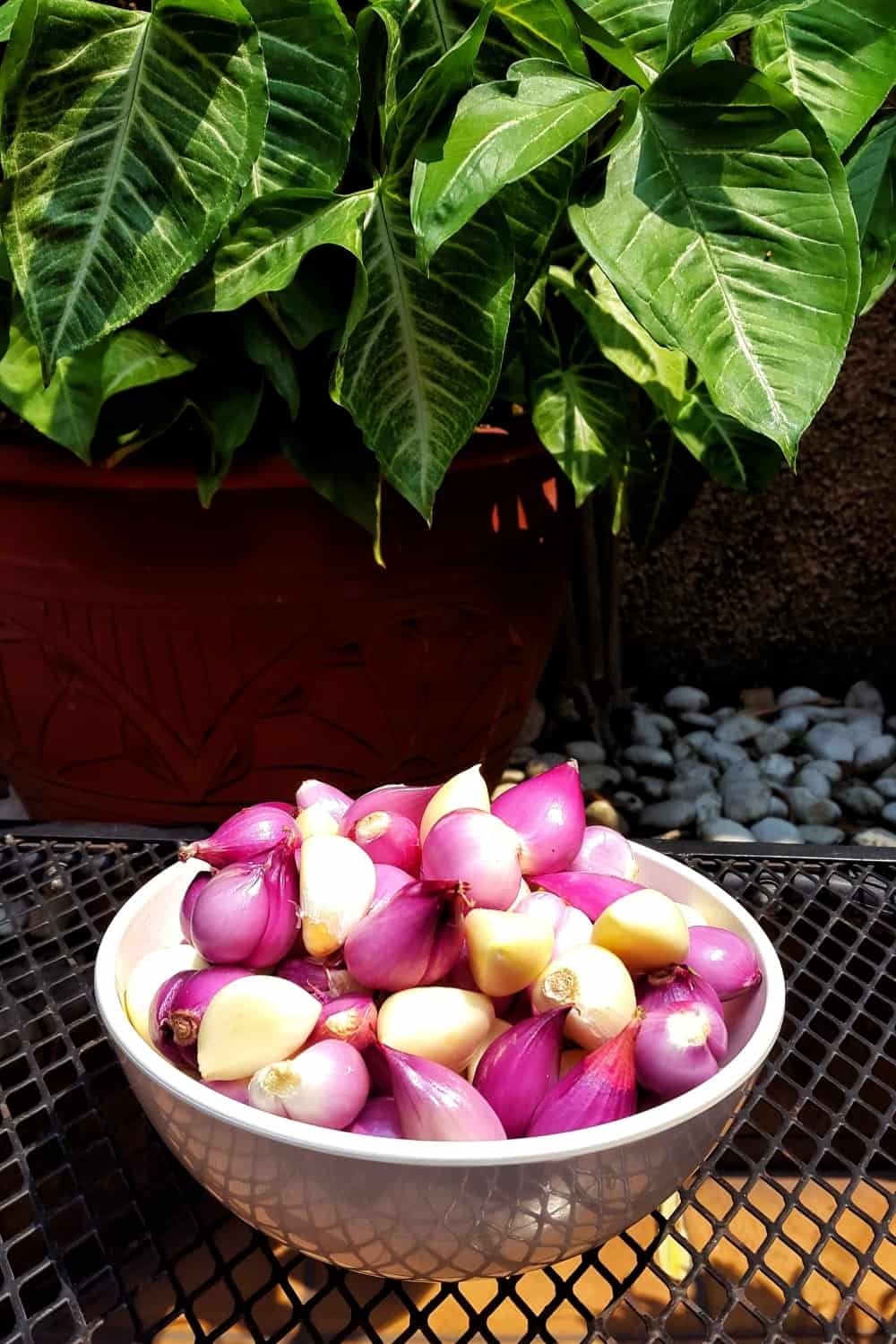
Shallots are a type of vegetable that also come from the family of onions, garlic, and chives. Shallots are native to Central Asia and have been cultivated for centuries for their culinary uses.
Similarities:
• Both belong to the same Allium family, which includes onions, garlic, chives, and leeks.
• Both shallots and garlic powder provide strong and distinctive aromatic flavors to dishes.
• Shallots, when stored properly in a cool, dry place, can have a longer shelf life compared to other fresh bulb vegetables. Garlic powder also has a long shelf life due to its dehydrated form.
Differences:
• Shallots are a type of bulbous vegetable, while garlic powder is a dried, powdered form of garlic cloves.
• Shallots have a unique flavor that combines elements of onions and garlic, while garlic powder provides a concentrated and pungent garlic taste.
• Shallots have a firm and crisp texture when raw. They become softer and more tender when cooked.
Garlic powder, on the other hand, dissolves and disperses easily in liquids or adheres to the surface of ingredients. It does not provide any textural element like shallots.
How To Use As A Substitute:
You won’t achieve the exact flavor of garlic powder when using shallots as a substitute.
If you are fine with that, you can use 1-2 teaspoons of finely chopped or minced shallots to replace 1 teaspoon of garlic powder.
When preparing the shallots, it is best to sauté or cook them before adding them to dishes in order to mellow their flavor and bring out their sweetness.
I usually add shallots early in the cooking process to allow them to cook and infuse their flavor into the dish. However, be mindful of their delicate nature and avoid overcooking, as they can lose their distinctive taste and become mushy.
You can use shallots in many dishes, including sauces, dressings, marinades, soups, stir-fries, and other savory recipes.
See Also: 10 Substitutes For Leeks That Will Win Your Cooking Game
9. Onion Powder
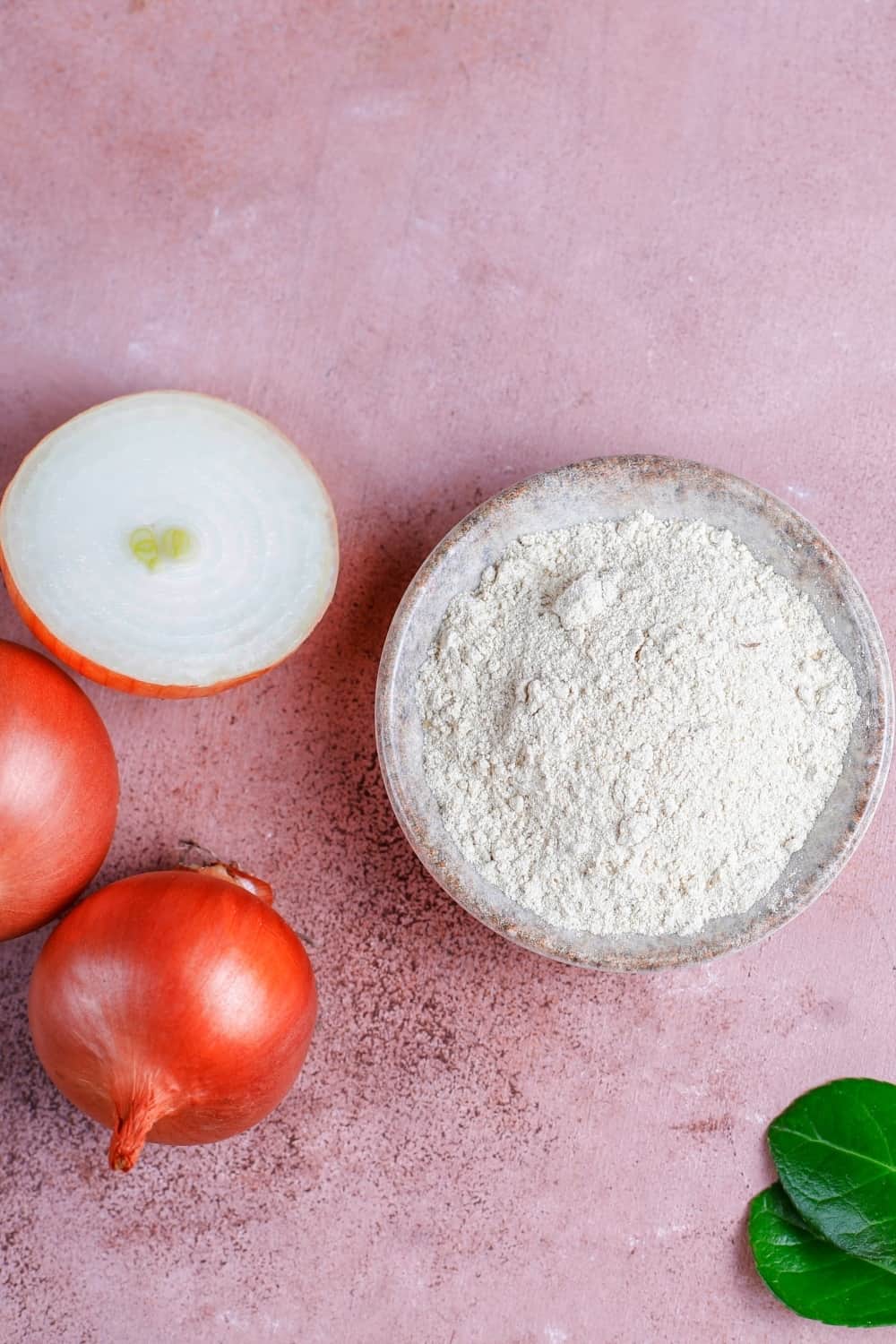
Finally, there is one powder that can be used as a decent substitute. This time, it is made from dried onions. It is not a perfect alternative to be honest, but it has some advantages.
Similarities:
• The most obvious similarity between garlic and onion powder is the fact that they both come in the powdered form, which is a huge advantage when substituting.
• Although not quite the same, both powders provide strong and distinct aromas and they both work as flavor enhancers.
• They also have long shelf lives when properly stored in a cool, dry place.
Differences:
• As they are made from two different types of vegetables, they also have different flavors. Onion powder has a characteristic sweet and pungent flavor that resembles onions, while garlic powder offers a strong and pungent taste reminiscent of garlic.
• Onion powder has a distinct onion aroma that adds depth and complexity to dishes. The aroma of garlic powder is highly recognizable, providing a pungent and savory scent that can be quite intense.
• Also, garlic powder generally has a more intense flavor compared to onion powder.
How To Use As A Substitute:
The first thing you need to consider is the fact that onion powder has a milder and sweeter taste compared to garlic powder.
So, if you’re aiming for a more subtle garlic flavor, using onion powder can work well. However, if a strong garlic taste is crucial, consider combining onion powder with minced fresh garlic to achieve a more balanced result.
When it comes to the exact conversion ratio, it is best to start with a 1:1 ratio and adjust it according to these intensity differences. In my opinion, it is best to use slightly more onion powder due to its milder flavor.
You can add onion powder to recipes in the same way as garlic powder. Sprinkle it directly into the dish during cooking or add it to sauces, marinades, dressings, or spice blends.
The powder will dissolve and distribute its flavor during the cooking process.
10. Asafoetida Powder

My final recommendation is asafoetida powder, also known as hing. It is a spice commonly used in Indian and Middle Eastern cuisine, and it is derived from resin of the Ferula assa-foetida plant, which is native to Central Asia.
Similarities:
• Besides the fact that they both come in powdered form, both garlic powder and asafoetida powder have strong and pungent aromas as well.
• They are both concentrated forms of their respective ingredients and they offer more concentrated flavors.
• Both garlic powder and asafoetida powder are used as flavor enhancers in cooking. They add depth, umami, and savory notes to dishes.
Differences:
• Asafoetida powder has a strong, pungent aroma that is often described as sulfurous, while garlic powder has a characteristic garlic scent that is pungent and savory.
• Asafoetida powder and garlic powder have distinct flavor profiles. Garlic powder delivers a pronounced garlic taste that is savory, pungent, and slightly sweet.
Asafoetida powder, when cooked, develops a complex flavor with onion and garlic undertones, but it has its own unique taste that is difficult to replicate with any other ingredient.
• Unlike garlic powder and garlic products in general, asafoetida is often recognized for its digestive properties and is used in traditional medicine systems like Ayurveda. It is believed to help alleviate gas, bloating, and other digestive issues.
How To Use As A Substitute:
Asafoetida powder has a stronger and more intense flavor compared to garlic powder.
I would therefore recommend you to use about ¼ to ½ teaspoon of asafoetida powder for every 1 teaspoon of garlic powder.
Once you choose the right amount, you should heat it in a fat or oil to release its flavors and mellow its pungent aroma.
Similar to garlic powder, add a small amount of asafoetida powder to hot oil or ghee at the beginning of the cooking process.
Sauté the powder for 10-15 seconds, until it becomes fragrant. This helps to develop its unique flavor and reduces the raw aroma.
You can use it in many types of dishes, including lentil curries, vegetable dishes, rice preparations, and pickles.
Consider recipes where garlic powder is used for its flavor enhancement and add asafoetida powder accordingly.
Keep in mind that asafoetida has a distinct taste, so the resulting flavor may not be an exact replica of garlic powder, but it can still add depth and richness to a dish.
Making Your Own Garlic Powder (Video)
Finally, if you want to know how to make your own garlic masterpiece in the form of powder, here is the video you must watch.


